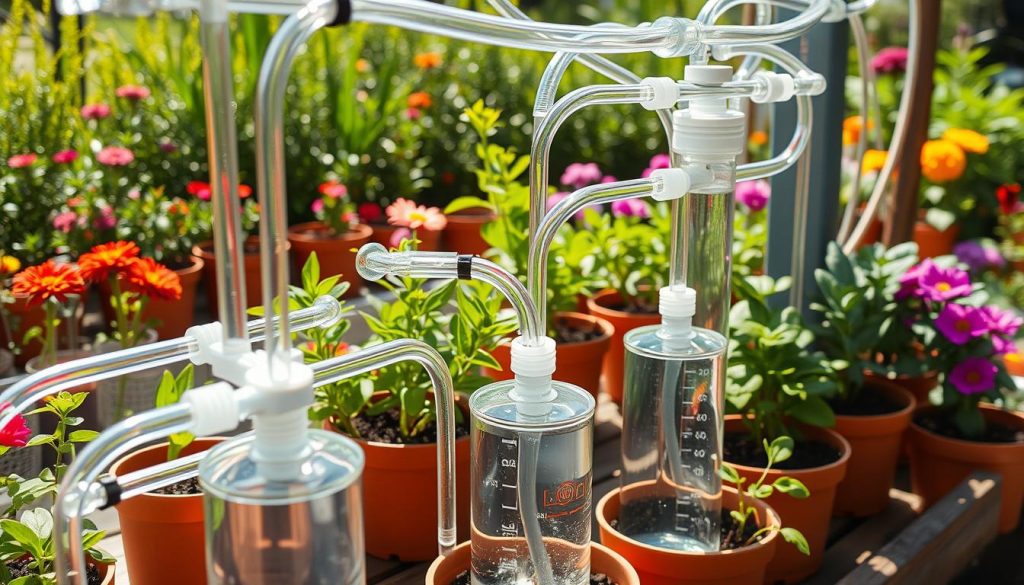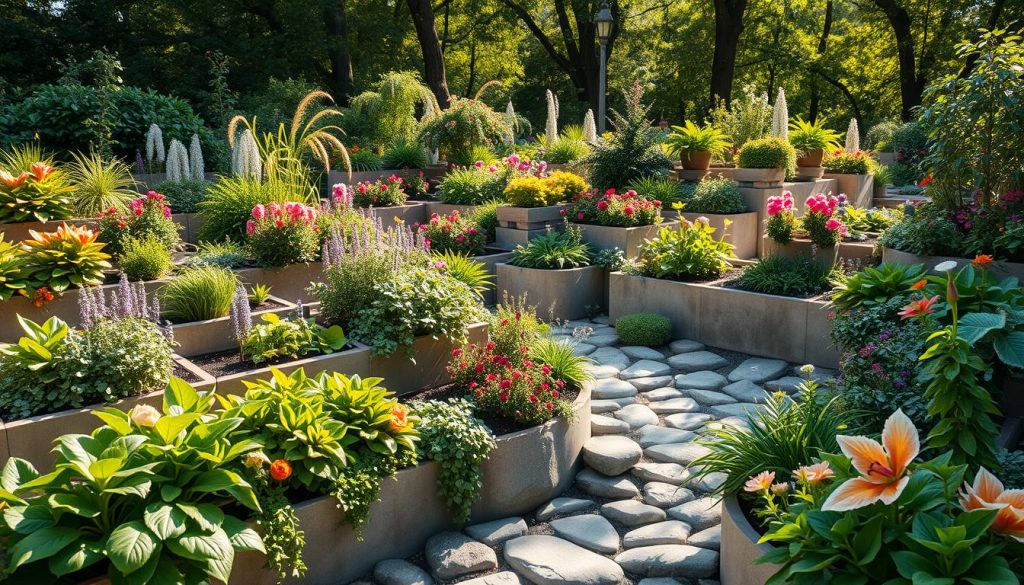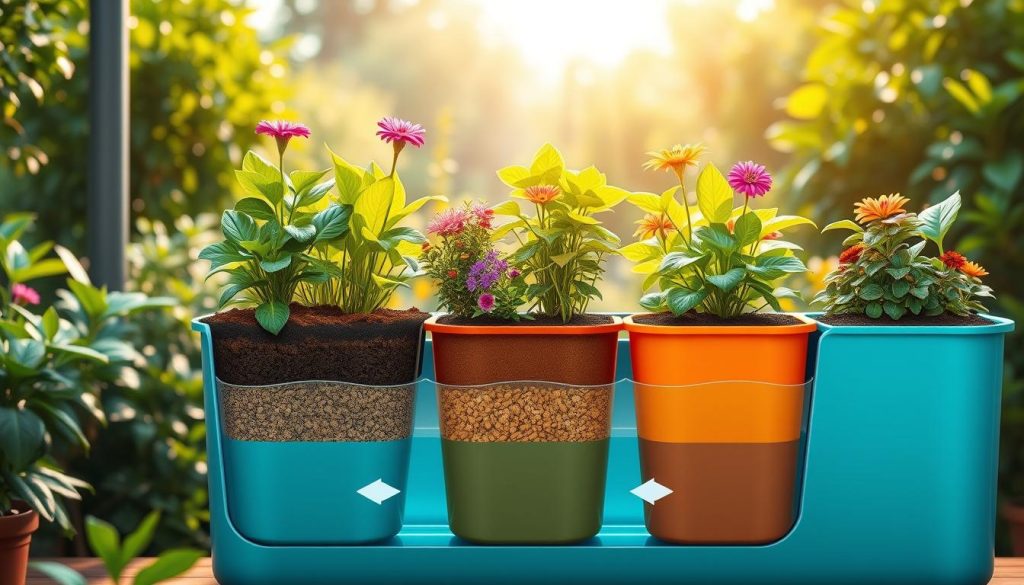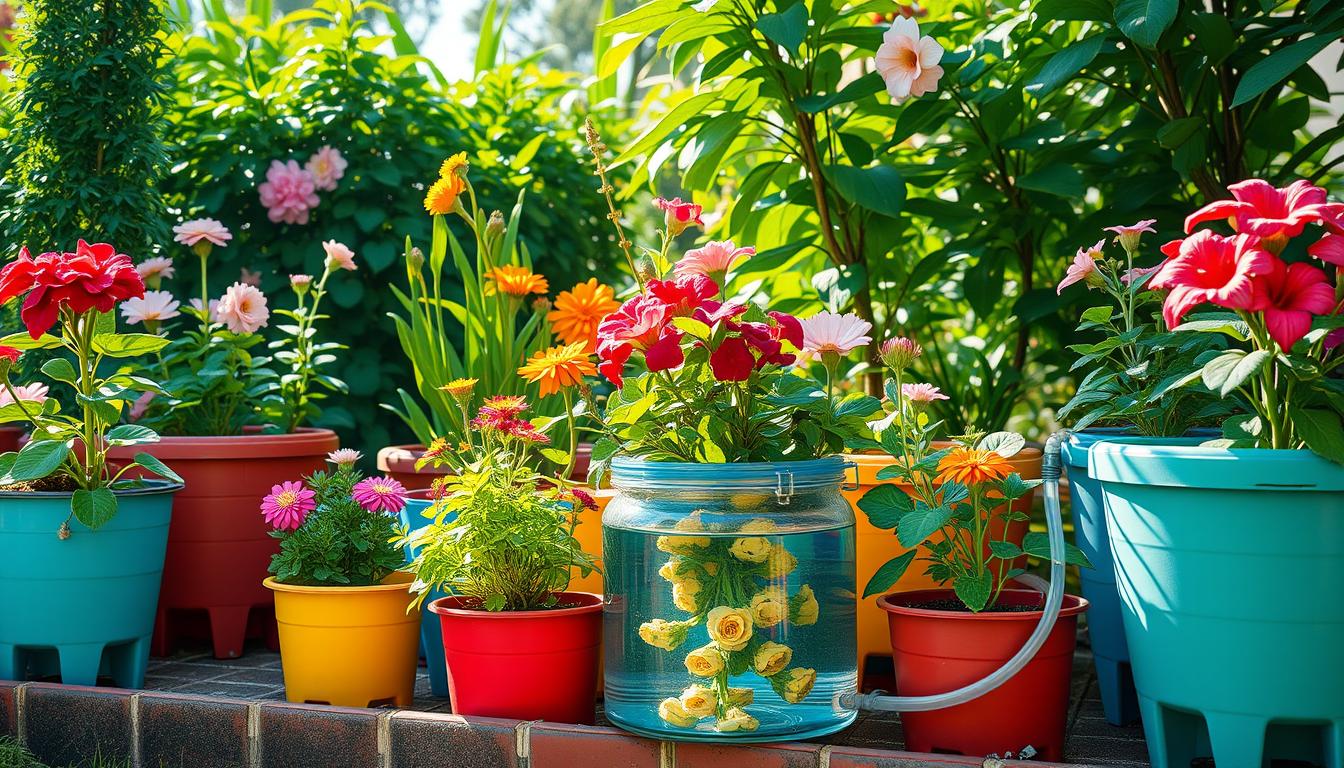I’m excited to share my experience on creating a self-watering garden. It’s a great way to grow plants with little effort. A self-watering garden setup is perfect for busy people or new gardeners. With a self-watering planter guide, you can start easily.
A self-watering garden is perfect for those who want a beautiful garden without spending too much time on it. To start, you need to understand the basics of creating a self-watering garden and its benefits. With this setup, you can enjoy your plants with less need for frequent watering.
In this article, I’ll cover the essential steps to create a self-watering garden. This includes choosing the right plants, designing a garden layout, and building a self-watering system. Whether you want an indoor or outdoor self-watering garden, this guide will help you get started. You’ll enjoy the benefits of a low-maintenance garden.
Understanding the Basics of Self-Watering Gardens
To have a thriving garden with little upkeep, knowing self-watering gardens is key. These gardens water plants on their own, cutting down on the need for constant watering. You can make one yourself, from a simple watering globe to a complex drip system.
Self-watering gardens save water by delivering it right to the roots. This cuts down on evaporation and runoff. It also helps avoid overwatering, which harms plants. For indoor gardens, tips on self-watering plants can be super helpful. They help control watering and prevent root rot.

What is a Self-Watering Garden?
A self-watering garden stores water in a reservoir. Plants draw water up as they need it. This can happen through capillary action, wicking, or drip irrigation. Such a system makes gardening easy and efficient.
Benefits of Self-Watering Systems
Self-watering systems offer many benefits. Some key ones are:
- Less water waste
- Healthier plant growth
- Less upkeep needed
- Better plant health
By using a DIY watering system and following indoor tips, you can have a low-care garden. Self-watering gardens are great for anyone wanting to help the environment while enjoying gardening.
Selecting the Right Plants for My Self-Watering Garden
Choosing the right plants is key for a thriving self-watering garden. I look for plants that do well in a self-watering system and add beauty to my outdoor space. For beginners, starting with easy-to-care-for plants is best.
Herbs like basil and mint, succulents like aloe and echeveria, and vegetables like tomatoes and cucumbers are great choices. These plants have similar needs and grow well together, making them perfect for self-watering gardens.
Best Plants for Beginners
- Herbs: basil, mint, and cilantro
- Succulents: aloe, echeveria, and crassula
- Vegetables: tomatoes, cucumbers, and carrots
Considerations for Plant Compatibility
When picking plants, I think about the climate, soil, and sunlight they need. I also consider how each plant will grow together in a self-watering container. Choosing plants with similar needs makes my garden harmonious and low-maintenance.

Designing My Self-Watering Garden Layout
Creating a self-watering garden starts with the layout. A good layout ensures plants get the right water and nutrients. It also makes the most of the space available. I start by thinking about where my garden will be. I consider the sunlight and wind it will get.
This helps me pick the right plants and containers. A self-watering planter guide is essential here. I look for planters with a built-in water reservoir. These are great for beginners because they’re easy to use and need little care.
For a cheaper option, I might use DIY containers. Plastic bottles or wooden planters can be turned into self-watering ones with a few tweaks.

- Size: Choose containers that are large enough to hold the soil and plants, but not so large that they become too heavy or difficult to move.
- Material: Select containers made from durable, water-resistant materials, such as plastic or wood.
- Drainage: Ensure that the containers have adequate drainage holes to prevent waterlogged soil.
By following a self-watering planter guide and considering these factors, I can create a thriving self-watering garden. This garden will need little maintenance and care.
Materials Needed to Build My Self-Watering System
To make a homemade self-watering irrigation system, I need to gather the right materials. I’ll need a water reservoir, tubing, and a watering mechanism. You can build a DIY automatic watering system with plastic containers, PVC pipes, and soil. Think about your garden’s size and the plants you have.
A key part of the system is the water reservoir. It can be a plastic container or a wooden barrel, depending on your garden’s style. The reservoir should hold enough water for your plants for several days. I also need to pick durable, UV-resistant tubing.
Essential Tools and Supplies
- Water reservoir
- Tubing
- Watering mechanism
- Soil and plants
- PVC pipes and fittings
Budget-Friendly Alternatives
To build a self-watering system without spending a lot, use recycled materials. Old plastic containers like buckets or tubs work great as a water reservoir. PVC pipes and fittings can help create a DIY automatic watering system. Using recycled materials makes your system efficient and affordable.
Step-by-Step Guide: Building My Self-Watering Garden
To make a self-watering garden, you need a good plan. I started by picking the right spot and choosing the best plants for my garden.
First, I got the base ready and set up the reservoir. I picked a container and put in small rocks for better drainage. Then, I added a water reservoir to hold extra water, cutting down on watering.
Preparing the Base and Reservoir
- Choose a container with good drainage holes
- Add a layer of small rocks or broken pottery
- Install a water reservoir to store excess water
Assembling the Watering System
Setting up the watering system is key. I connected the reservoir to the plants’ roots. This lets them get water when they need it. With these steps and the right stuff, I made a low-maintenance self-watering garden.
Maintaining My Self-Watering Garden
Keeping a self-watering garden healthy takes some effort, but it’s worth it. To keep my garden thriving, I follow a few easy steps. First, I check the water level in the reservoir and refill it when needed. This keeps the system working right.
I also watch the soil moisture and adjust the watering schedule as needed. This helps avoid too much or too little water. Lastly, I prune dead or overgrown plants to keep them healthy and prevent pests or diseases.
Troubleshooting Common Issues
If problems like clogged drainage or root rot show up, I act fast. Knowing how to fix common issues helps me keep my garden looking great. Adding decorative elements or companion plants can also make my garden more beautiful and useful.
Creating a self-watering garden has been a rewarding journey. I’m excited to see how it will grow and flourish in the future. With proper care, I can enjoy my self-watering garden for many seasons.

